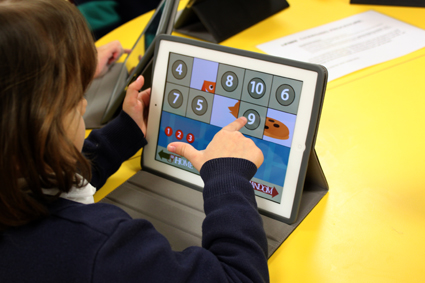
Durante la etapa infantil, los jóvenes suelen empezar a descubrir los dispositivos tecnológicos e incluso las redes sociales. Estas actividades resultan divertidas y relajantes, pero un uso en exceso puede tener un impacto negativo en su desarrollo. A continuación, detallamos ocho pautas del National Online Safety recomendadas a familias por nuestro departamento de Tecnologías de la Información en Primaria.
- Sea un ejemplo para los miembros de la familia más jóvenes. Ellos le observan cada vez que coge el móvil o tablet, incluso los bebés. Es importante demostrar cuándo es momento de utilizar la tecnología y cuándo no.
- Hable con ellos para explicar que debe haber límites y avíseles cuando se les acaba el tiempo para evitar frustraciones. Puede utilizar alarmas o temporizadores.
- Utilice los controles disponibles en los diferentes dispositivos o apps para restringir el tiempo de uso.
- Intente retrasar el momento de empezar a utilizar dispositivos electrónicos, animándolos a disfrutar de juguetes u otras actividades primero. Una vez delante de las pantallas, puede resultarles difícil dejarlas y producir un ambiente negativo.
- Pruebe a ofrecerles premios por periodos que no estén delante de la pantalla: pasar tiempo con una amistad o ir a tomar un helado.
- La pantalla puede ser un premio por terminar tareas en casa, como recoger los juguetes. Otra opción es ampliar el tiempo permitido con el dispositivo como recompensa.
- Mantenga las comidas, reuniones familiares o sociales libres de pantallas para todos los miembros de la familia, incluso apagando los televisores.
- Prepare con ellos una “bolsa especial” de sus objetos o juguetes favoritos como alternativa a la pantalla, como pegatinas, bolis, Legos o muñecos. Luego pueden elegir una cosa de la bolsa para divertirse.
Children often begin to discover electronic devices and even social media when they are toddlers. These activities are fun and relaxing for the child, but may have a negative impact on their development. Please find below eight guidelines from National Online Safety that our Primary Technologies of Information Department recommends for school families.
- Be an example for younger members of the family. Children watch and learn from you whenever you pick up your phone or tablet, even babies. It’s important to show them when it’s the right time to use technology and when it’s not.
- Speak with your children to explain that there should be limits and give them warnings before their time is up so that they don’t get frustrated. Using alarms or timers may be useful.
- Use the parental controls available to you on different devices or apps in order to restrict screen time.
- Try to delay the moment in time when children turn on an electronic device, encouraging them to enjoy time playing with their toys or other activities first. Once they are in front of a screen, they may find it difficult to turn it off, which could set a negative tone.
- Try offering them rewards for periods of time they are not using screens, such as spending time with a friend or going out for an ice cream.
- Screen time can be a reward for finishing chores, such as putting away their toys. Another option is to increase the time they are allowed to use a device as a reward.
- Keep meal times, family or social get-togethers free of screens for all members of the family, even turning off televisions.
- Ask children to help you put together a ‘fun bag’ of their things or favourite toys as an alternative to screens, filling it with stickers, pens, Legos or figurines. Later they can choose something from the bag to entertain themselves.











Leave a Reply